
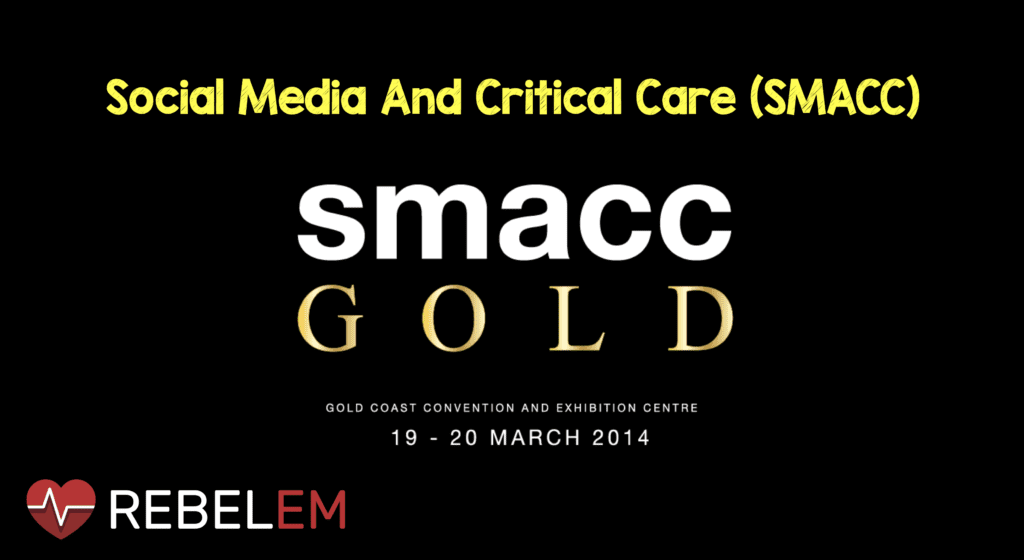 This year I was fortunate enough to attend the Social Media And Critical Care (SMACC) conference from Mar 19th – 21st, 2014 at the Gold Coast Australia, also known as SMACCGOLD. SMACC is a modern, academic meeting, mixed with on-line technologies to deliver innovation in education in the fields of emergency medicine and critical care. This conference addresses important clinical issues in a format that is energetic, cutting edge, and yet reputable. So what did I learn? Well, more than I can put into one post, but some of the highlights are listed below.
This year I was fortunate enough to attend the Social Media And Critical Care (SMACC) conference from Mar 19th – 21st, 2014 at the Gold Coast Australia, also known as SMACCGOLD. SMACC is a modern, academic meeting, mixed with on-line technologies to deliver innovation in education in the fields of emergency medicine and critical care. This conference addresses important clinical issues in a format that is energetic, cutting edge, and yet reputable. So what did I learn? Well, more than I can put into one post, but some of the highlights are listed below.
Who were some of the people I got to meet and interact with at the conference?

Well just to name a few….
- Chris Nickson (@precordialthump) Co-Creator of Life in the Fast Lane & The Rage Podcast
- Tessa Davis (@TessaRDavis) Author/Editor of Don’t Forget the Bubbles
- Natalie May (@_NMay) Author/Editor of St. Emlyn’s Blog
- Karim Brohi (@karimbrohi) Trauma Surgeon
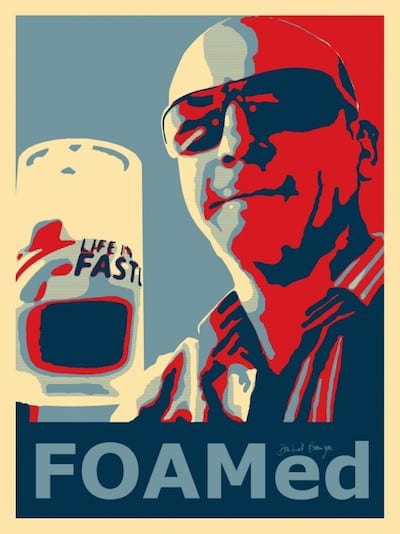 Scott Weingart (@emcrit) EM/Critical Care and Author/Editor of EMCrit.org
Scott Weingart (@emcrit) EM/Critical Care and Author/Editor of EMCrit.org- Richard Levitan (@airwaycam) Creator/Author of Airway Cam Blog
- Casey Parker (@broomedocs) Creator/Author of Broome Docs Blog
- Matt Dawson and Mike Mallon (@ultrasoundpod) Creators/Authors of Ultrasound Podcast
- Rob Mac Sweeney (@CritCareReviews) Creator/Author of Critical Care Reviews
- Cliff Reid (@cliffreid) Creator/Author of Resus.Me
- Victoria Brazil (@SocraticEM) Medical Educator
- Steve Smith (@smithECGBlog) Creator/Author of Dr. Smith’s ECG Blog
- Simon Carley (@EMManchester) Author/Editor of St. Emlyn’s Blog
- Michelle Johnston (@Eleytherius) Medical Educator
- Louise Cullen (@louiseacullen) Clinical Acute Cardiac Disease Researcher
- Minh Le Cong (@rfdsdoc) Creator/Editor of Prehospital And Retrieval Medicine (PHARM) Blog
- Rob Rogers (@EM_Educator) Course Director of The Teaching Course
- Haney Mallemat (@CriticalCareNow) On The Rage Podcast
- Andy Neill (@AndyNeill) Creator/Author of Emergency Medicine Ireland Blog
- Jesse Spurr (@Inject_Orange) Creator/Author of Injectable Orange Blog
What can Free Open Access Meducation (FOAM) do for you?

Emergency Medicine is a persistently changing field in which there is significant practice pattern variation amongst physicians. Changes in practice typically have a very slow uptake in medicine, in general, but are an essential part of clinical practice and what’s best for our patients. FOAM will allow you to overcome the chasm that commonly occurs in medicine by having a more real time knowledge translation of best clinical practices through interaction and collaboration.
What did I learn from the Social Media And Critical Care (SMACC) Conference?

There was so much great information, that there is no way I can list all of it in one post. Instead, I will mention my top 10 lessons learned…
-
 Airway management is all about mindset and rescuing an airway is too late, we should be proactive with airway management.
Airway management is all about mindset and rescuing an airway is too late, we should be proactive with airway management. - Vasopressors can be started in peripheral IVs until central venous catheter is placed. [1]
- Have you heard of The proCESS Study? Well it turns out we are now better at looking for sepsis, work hard to resuscitate septic patients with early IVF and antibiotics, and maybe monitoring (i.e. CVP and MAP) may not matter
- Patients receiving end-of-life care often come to ED and we can be a critical decision-making point where goals of care are established and we can take great satisfaction not only in our great saves but in the satisfaction of letting people die well. In the end “Cure sometimes, treat often, and comfort always.” -Hippocrates-
-
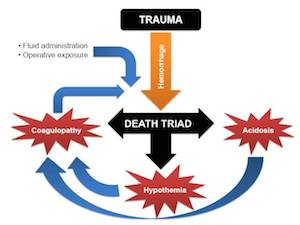 In Damage Control Resuscitation (DCR) in trauma patients the earliest key to survival is hemorrhage control and DOES NOT apply to trauma patients who are not hemorrhaging. The 4 pillars of DCR are early bleeding control, permissive hypotension, limiting IVF (dilution), and targeting coagulopathy.
In Damage Control Resuscitation (DCR) in trauma patients the earliest key to survival is hemorrhage control and DOES NOT apply to trauma patients who are not hemorrhaging. The 4 pillars of DCR are early bleeding control, permissive hypotension, limiting IVF (dilution), and targeting coagulopathy. - We need practice doing cricothyrotomies, we need to know the anatomy involved in doing cricothyrotomies, and if you do a cricothyrotomy do it bougie-assisted.
- Resuscitative endovascular balloon occlusion of the aorta (REBOA) is a potentially lifesaving maneuver in the setting of hemorrhagic shock.
- Emergency Department Extracorporeal Membrane Oxygenation (ECMO) and Extracorporeal cardiopulmonary resuscitation (ECPR) are realities that are coming to EDs and initiated by emergency physicians in patients with cardiac arrest [cite source=”pubmed”]22306260[/cite].
-
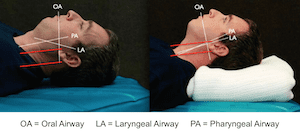 When preparing to intubate a patient, remember the “ear to sternal notch” position is the ideal position.
When preparing to intubate a patient, remember the “ear to sternal notch” position is the ideal position. - In patients with extra-axial intracranial hematomas an emergency burr hole evacuation may have to occur from the emergency medicine physician if neurosurgery is not available [2]
*Checkout some other reflections from smaccGOLD:
- Damian Roland (@Damian_Roland) on his blog The Rolobot Rambles
- Chris Nickson (@precordialthump) on Life in the Fast Lane
- Jesse Spurr (@Inject_Orange) on his blog Injectable Orange
- Eve Purdy (@Purdy_Eve) on her blog Manu et Corde
- Andy Neill(@AndyNeill) on his blog Emergency Medicine Ireland
- Robert Simpson (@AmboFOAM) on his blog AmboFOAM
- Iain Beardsell (@docib) on St. Emlyn’s Blog
What else went on during the conference?

SMACC Sono Wars: Northern Hemisphere (Ultrasound Podcast) vs Southern Hemisphere (The Sono Cave)

SMACC Sim Wars: By the way Boba Fett (Scott Weingart) and Alien (Cliff Reid)
Where and when will the conference take place next year (2015)?
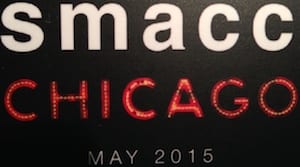
May 20 – 22nd, 2015 Chicago, IL
I believe Joe Lex (@JoeLex5) put it best when he said:
- If you want to know how we practiced medicine 5 years ago, read a textbook.
- If you want to know how we practiced medicine 2 years ago, read a journal.
- If you want to know how we practice medicine now, go to a conference.
- If you want to know how we will practice medicine in the future, listen in the hallways and use FOAM.
References:
- Ricard JD et al. Central or Peripheral Catheters for Initial Venous Access of ICU Patients: A Randomized Controlled Trial. Critical Care Med 2013. PMID: 23782969
- Wilson MH et al. Emergency Burr Holes: ” Ho to Do It.” Scand J Trauma Resuscitation Emerg Med 2012. PMID: 22469190
The post Social Media And Critical Care (SMACC) appeared first on REBEL EM - Emergency Medicine Blog.
